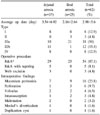Abstract
Purpose
Intestinal atresia is a common cause of neonatal intestinal obstruction. Recently, the survival rate has been increasing from development of prenatal diagnosis, total parenteral nutrition (TPN) and neonatal intensive care. We evaluated the complication rate and cause of mortality after operative management for jejunoileal atresia.
Methods
We reviewed 62 patients (36 males, 26 females) with jejuno-ileal atresia who underwent operation from 1998 to 2007.
Results
There were 37 patients with jejunal atresia and 25 with ileal atresia. The average gestational age was 256±16.6 days and birth weight was 2,824±620 g. Prenatal diagnosis was performed in 45 patients (72.6%) around gestational age 27 weeks. Within 2nd day after birth, 44 patients (71%) underwent operation. Half of the jejunoileal atresia was type IIIa and type I was in 8, type II was in 3, type IIIb was in 12, and type IV was in 8. The operative treatment was resection & anastomosis in 59 patients and enterotomy & web excision in 3. They started feeding at 12.4±11.5 days after operation on average. The average duration of TPN was 26.7±23.5 days, and the incidence of cholestasis was 30.6%. Hospital days averaged 36.8±26 days. Early complication occurred in 14 patients (intestinal obstruction in 5, sepsis in 4, wound problem in 3, anastomosis leakage in 1, and intraabdominal abscess in 1). Late complication occurred in 7 patients (anastomosis stricture in 4 and intestinal obstruction in 3). There was only one case of mortality due to short bowel syndrome after re-operation for adhesive ileus.
References
1. Tandler J. Zur entwicklungsgeschichte des menschlichen duodenum in fruhen embryonalstadien. Morphol Jahrb. 1900. 29:187–216.
2. Louw JH, Barnard CN. Congenital intestinal atresia; observations on its origin. Lancet. 1955. 269:1065–1067.
3. Cragan JD, Martin ML, Moore CA, Khoury MJ. Descriptive epidemiology of small intestinal atresia, Atlanta, Georgia. Teratology. 1993. 48:441–450.
4. Walker K, Badawi N, Hamid CH, Vora A, Halliday R, Taylor C, et al. A population-based study of the outcome after small bowel atresia/stenosis in New South Wales and the Australian Capital Territory, Australia, 1992~2003. J Pediatr Surg. 2008. 43:484–488.
5. Forrester MB, Merz RD. Population-based study of small intestinal atresia and stenosis, Hawaii, 1986~2000. Public Health. 2004. 118:434–438.
6. Smith GH, Glasson M. Intestinal atresia: factors affecting survival. Aust N Z J Surg. 1989. 59:151–156.
7. Sato S, Nishijima E, Muraji T, Tsugawa C, Kimura K. Jejunoileal atresia: a 27-year experience. J Pediatr Surg. 1998. 33:1633–1635.
8. Dalla Vecchia LK, Grosfeld JL, West KW, Rescorla FJ, Scherer LR, Engum SA. Intestinal atresia and stenosis: a 25-year experience with 277 cases. Arch Surg. 1998. 133:490–497.
9. Kim IK, Kim SY, Kim SK, Kim WK, Kim JE, Kim JC, et al. Intestinal atresia: a survey by the Korean Association of Pediatric Surgeons. J Korean Assoc Pediatr Surg. 1999. 5:75–81.
10. Choi SO, Park WH. Congenital intestinal atresia and stenosis. J Korean Surg Soc. 1991. 41:439–448.
11. Jung SE, Nam SJ, Park KW, Lee SC, Kim WK. Congenital small bowel obstruction. J Korean Surg Soc. 1992. 42:81–86.
12. Cho WH, Kim JS, Park JS. Clinical features of small intestinal atresia. J Korean Surg Soc. 2000. 59:532–538.
13. Park J. A clinical analysis of the intestinal atresia. J Korean Assoc Pediatr Surg. 2004. 10:99–106.
14. Jeong IO, Choe YM, Kim JY, Choi SK, Heo YS, Lee KY, et al. Clinical considerations of intestinal atresia. J Korean Surg Soc. 2009. 77:423–428.
15. Weber TR, Vane DW, Grosfeld JL. Tapering enteroplasty in infants with bowel atresia and short gut. Arch Surg. 1982. 117:684–688.
16. Waldhausen JH, Sawin RS. Improved long-term outcome for patients with jejunoileal apple peel atresia. J Pediatr Surg. 1997. 32:1307–1309.
17. Cloutier R. Intestinal smooth muscle response to chronic obstruction: possible applications in jejunoileal atresia. J Pediatr Surg. 1975. 10:3–8.
18. Nixon HH. Intestinal obstruction in the newborn. Arch Dis Child. 1955. 30:13–22.
19. Louw JH. Congenital intestinal atresia and stenosis in the newborn. Observations on its pathogenesis and treatment. Ann R Coll Surg Engl. 1959. 25:209–234.
20. Thomas CG Jr. Jejunoplasty for the correction of jejunal atresia. Surg Gynecol Obstet. 1969. 129:545–546.
21. Chung JH, Kim SH, Song YT. Experience with tapering enteroplasty in intestinal atresia. J Korean Assoc Pediatr Surg. 2007. 13:23–29.
22. Aspirot A, Su W, Flageole H, Puligandla PS, Shaw K, Laberge JM. Cholestasis associated with small bowel atresia: do we always need to investigate? J Pediatr Surg. 2007. 42:873–877.
23. Chirdan LB, Uba AF, Pam SD. Intestinal atresia: management problems in a developing country. Pediatr Surg Int. 2004. 20:834–837.
24. Piper HG, Alesbury J, Waterford SD, Zurakowski D, Jaksic T. Intestinal atresias: factors affecting clinical outcomes. J Pediatr Surg. 2008. 43:1244–1248.
25. Touloukian RJ. Diagnosis and treatment of jejunoileal atresia. World J Surg. 1993. 17:310–317.
26. Burjonrappa SC, Crete E, Bouchard S. Prognostic factors in jejuno-ileal atresia. Pediatr Surg Int. 2009. 25:795–798.
27. Stollman TH, de Blaauw I, Wijnen MH, van der Staak FH, Rieu PN, Draaisma JM, et al. Decreased mortality but increased morbidity in neonates with jejunoileal atresia; a study of 114 cases over a 34-year period. J Pediatr Surg. 2009. 44:217–221.




 PDF
PDF ePub
ePub Citation
Citation Print
Print







 XML Download
XML Download